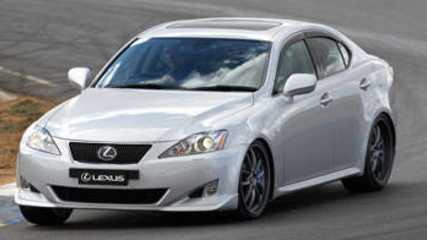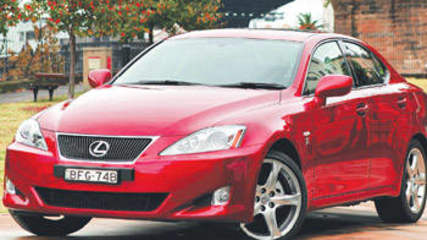Lexus IS250 X 2008 Review
By Paul Pottinger · 29 Apr 2008
...preservative-free beer; roasted pork knuckles served with dumplings; the city of Berlin. Stuff like that.It's also home to the compact prestige sedan. In its ideal form, this is powered by a six-cylinder engine and driven via the rear wheels.Since 2005, the Japanese, with their genius for emulation and improvement upon the original design, have also produced a healthy example of the species in the form of the Lexus IS250.Unlike the Germans, whose six-pot models are prohibitively expensive, the V6-only Lexus is priced from just under $55,000 — the cost of a top-end Commodore.There's now an “X”-badged edition of the IS250, giving us the excuse to not only revisit a favourite car but see what its rivals bring to the table for a similar sum.Fans of the Deutsch diesels though we are, we're sticking to petrol choices out of fairness to the Lexus, whose oiler variant isn't available in Australia. LEXUS IS250 X from $64,790Although this limited edition of 450 begins at $64K, the IS manual's action is awkward. Far better to go with the $67,390 six-speed sequential auto.A major attraction of the Lexus is its standard equipment list. Even the $54,390 Prestige model looks lavish next to the nearest-priced Mercedes or BMW.The limited-edition IS250 — distinguished by X badges in punkish cursive — cops sports suspension; a 14-speaker Mark Levinson stereo system; a sunroof; satnav; a rear-view camera with rear guide assist; a Bluetooth hands-free telephone system; sports pedals; metallic scuff plates;and unique five-spoke, 18-inch alloys.Nice colours, too.Pound for pound, the IS is the best current Lexus and easily the most enjoyable to drive.Its 153kW/252Nm V6, with direct injection and variable valve timing, isoften unfavourably compared to BMW's in-line mills.But, like so much about the IS, it suffices just fine in the real world, ticking over at 2000rpm at the 110km/h limit NSW motorists areprivileged to enjoy.Low-down response when the lever is left in drive isn't the most adroit — due partly to tall gearing and partly to a hefty 1600kg kerb weight — but can be enhanced by leaving the stick in sport and using the steering-wheel paddles.Mildly annoyingly, there's no temporary manual override.Sports-suspended and equipped with low-profile rubber, our test 250 rode tersely but with compliance bested only by the Mercedes.Its touch-screen multimedia set-up (with an excellent reversing camera) left the Bimmer's costly, optional-extra i-Drive for dead.PROS: Highly satisfying RWD dynamics; light but informative steering; four-year-warranty; striking looks; superb value.CONS: Poor rear three-quarter vision; space-saver spare; it'sstrictly a four-seater;foot-operated parking brake. MERCEDES-BENZ C200K AVANTGARDE from $62,820YOU still need $86,000 to buy a C-Class with six pots, but the C200K is no longer a try-hard's car. Using the E-Class's version of the supercharged, 1.8-litre, four-cylinder petrol engine, it achieves respectability if not rapidity.With 135kW and 250Nm (30 more units of each than previously) driven through a five-speed automatic, the C-Class gets to 100km/h from rest in a claimed 8.6 seconds. A similar time to the V6 Lexus, actually.The Merc's response, especially when set insport mode, is backed by dynamics and bodycontrol that are altogether sharper thanin days of yore.The C-Class isn't 3 Series-keen, due in part to its heavier 1490kg kerb weight, but the Mercedes rides our raddled roads with the aplomb of a native son. The BMW doesn't.PROS: That badge; the best ride; the best retained value; the best value C-Class ever.CONS: Options not cheap; tight in the back seats; engine note sounds crook (as opposed to sick). BMW 323i from $65,000IF we seem to be Bimmer-bashing, we do so with a heavy heart, because the entry model of the Three Series sixes is the driver's choice of this trio. In certain circumstances ...Running a version of the 325i's 2.5-litre in-line six detuned to 140kW/230Nm, it remains a glorious thing — especially when mated to the crisp, six-speed manual. The benchmark ZF auto ($67,600) is still a good thing, though. Unlike the Lexus, the latter will not hold a gear at redline inmanual mode, but it's a good deal more adroit in drive. On smooth surfaces, the 323i has the edge on the others. Butthis is NSW, not Bavaria, and such stretches of bitumen areever more elusive. The run-flat tyres that afflict all but a few current BMWs are a deal-breaker. Do any real damage to your tyre any distance from the metropolis and, sorry, but you're stuck there until a new one can be delivered. That may not happen often, but the tramlining, skittering ride run-flats can provide is a constant. The stylised cabin, which may have seemed cool to the designers, looks austere to anyone shopping across the marques. Only three years after the E90 was released, it already looks dated. As for options, try $1600 for metallic paint.PROS: Inspiring engine, emotionally appealing and still thedriver's choice ...CONS: ... but only in ideal conditions; rotten ride, especially with M sports kit; run-flat tyres; spartan cabin; costly options.



